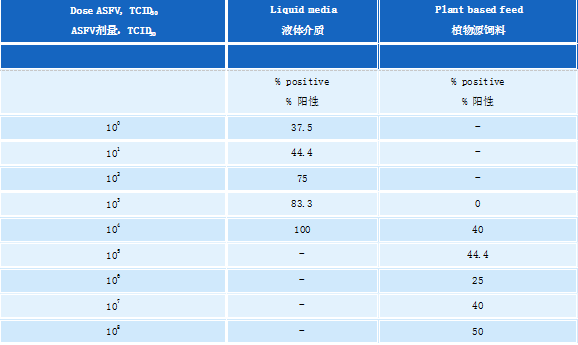
In a world where feed ingredients are marketed globally, do we know the minimum infectious dose to transmit the ASF virus in feed? And in water?
在一个饲料成分全球销售的环境中,通过饲料传播ASF病毒的最低感染剂量是多少?而通过饮用水又是多少?
The African swine fever epidemic that is affecting Central Europe and Asia never fails to surprise us, especially the apparent ease with which some farms have been infected, including some farms with apparent good biosecurity. This is the case for some of the infected industrial farms in Romania or Bulgaria. The fact that the Romanian Official Veterinary Services considered the water from the Danube river as a likely source of infection of one of these large farms, set all the alarm bells ringing, as reviewing literature there was no data about it.
正在影响中欧和亚洲的非洲猪瘟疫情总是让我们感到惊讶,特别是一些农场感染疫情明显很容易,包括一些生物安全状况明显良好的农场。罗马尼亚和保加利亚一些受感染的工业农场就是这种情况。罗马尼亚官方兽医服务机构认为多瑙河的水可能是这些大型农场中某一个的感染源,这一事实敲响了所有警钟,因为审查文献时没有相关数据。
The present article is interesting, as for the first time it establishes what the minimum infective doses should be in water and feed to generate an ASF infection. That contaminated water or feed can carry the infection should come as no surprise, as we have known for years that feeding pigs with contaminated food has been one of the main routes of ASF infection. But I think it is important not to panic and start to think that any feed or water used in a farm can be infecting material, especially if we consider the experience we have in Spain with the disease.
这篇文章很有意思,因为其第一次确定了在水中和饲料中产生非洲猪瘟感染的最低感染剂量。被污染的水或饲料可以携带感染并不奇怪,因为我们多年来已经知道,用被污染的食物喂养猪一直是感染非洲猪瘟的主要途径之一。但我认为,重要的是不要恐慌,不要认为农场使用的任何饲料或水都可能是感染材料,尤其是考虑上我们在西班牙获得的经验。
To be better understood, I have allowed myself to perform a few small calculations to see what it is the real probability of reaching infecting concentrations in drinking water. To make it more graphic I have taken the example of the theoretically infected farm from the water taken from the Danube. Does anyone know how many infected dead pigs should fall or be thrown into the Danube to get a dose of 101 TCID50?
为了便于理解,我做了一些小小的计算,看看饮用水中达到感染浓度的真实概率是多少。为了使它更生动,我举了一个例子,一家从多瑙河取水的农场理论上受感染的几率。有谁知道,要达到101 TCID50的剂量,应该有多少受感染的死猪掉进或被扔进多瑙河?
Well, considering the data on the average flow of the Danube: 6500 m3/s and taking into account that the average weight of the pigs thrown into the Danube would be 50 kg and that all the blood present in these (65 ml/ kg weight) was diluted in the water of the Danube and that concentration of virus in blood was the same as detected in cases of an acute infection: 3 x 106 copies/200 microliters (Blome et al., 2013) it would be necessary that every day at least 115 pigs would fell or would be thrown into the river, that all the blood contained in their bodies would be diluted in the drinking water and that this water was not subjected to any disinfection system that could reduce its viral load.
考虑到多瑙河的平均流速为6500立方米/秒,扔进多瑙河的猪平均体重是50公斤,所有血液 (65毫升/公斤体重)稀释在多瑙河水里,在急性感染的情况下血液中的病毒浓度是一样的::3 x 106/ 200毫升(Blome等,2013)。那么,每天至少115头猪会跌进或将被扔进河里,体内所有血液中被稀释到饮用水中,这些水源未经任何减少病毒载量的消毒系统。
As far as raw materials are concerned and according to the same work, the infectious load should be greater than 105.6 TCID50 so it would seem a less likely route if we think of possible contamination in the source fields, but it can be a factor to take into account if the contamination occurs during storage.
原材料而言,根据相同的工作,传染性负载应大于105.6 TCID50,因此,作为传染源而言,似乎不太可能,但若考虑到存储问题,这是一个应该考虑的问题。
When considering the biosecurity of pig farms, taking into account this study, we will need to consider the sanitization of drinking water, especially where it comes from sources that may have some risk (such as rivers or water channels) and in relation to feed, the most important thing will be to ensure that both suppliers and users have safe storage systems that prevent contact of the raw material/ feed with sources of contamination (such as other animals: rodents, birds, wild boar).
提及养猪场的生物安全,本研究中,我们需要考虑饮用水的卫生处理,特别是当饮用水来源(如河流或水通道)暗藏风险时,而饲料方面,最重要的将是确保供应商以及用户都有安全的存储系统,以避免原料或饲料与污染源((如其他动物:啮齿动物、鸟类、野猪)接触接触。
What are they studying?
研究内容
African swine fever virus (ASFV) is a contagious, rapidly spreading, transboundary animal disease and a major threat to pork production globally. Although plant-based feed can be a potential route for virus introduction onto swine farms, little is known about the risks for ASFV transmission in feed or water. This research aims to determine the minimum and median infectious doses of the Georgia 2007 strain of ASFV through oral exposure during natural drinking and feeding behaviors.
非洲猪瘟病毒(ASFV)是一种传染性、快速传播的跨界动物疾病,对全球猪肉生产构成重大威胁。尽管植物源饲料可能是病毒进入养猪场的潜在途径,但人们对饲料或水中传播ASFV的风险知之甚少。本研究旨在通过自然饮水和喂养期间的口服暴露,确定乔治亚2007株的最低和中位感染剂量。
How was it done?
研究过程
Experimental infection was carried out in 68 healthy crossbreed pigs of around 52 days of age in a biosafety level 3 containment facility in 7 separate replications at the different doses. The source of virus was from spleen collected from pigs acutely infected with ASFV Georgia 2007 (the strain currently circulating in Europe and Asia). The dose of virus was titrated into different dilutions from 100 to 108TCID50/ml (50% tissue culture infectious dose per millilitre), that were added to 100 ml of liquid media (RPMI) or 100g of complete feed (free from animal based ingredients). The selection of the infectious dose was determined using the continuous reassessment method to adjust ID50 and optimise the dose determination curve. Pigs were feed and water restricted for 10-14 hours to ensure consumption of the spiked liquid or feed.
在3级生物安全隔离设施中,在68头健康杂交猪身上进行了7次不同剂量的重复试验,这些猪的年龄大约为52天。病毒来源于急性感染乔治亚2007株(目前在欧洲和亚洲流行的毒株)的猪的脾脏。病毒剂量滴定为100 ~ 108TCID50/ml的不同稀液(每毫升50%的组织培养感染剂量),加入100 ml液体培养基(RPMI)或100g全价饲料(不含动物成分)。感染剂量的选择采用连续重估法调整ID50 ,优化剂量测定曲线。猪的饲料和喝水时间限制为10-14小时,以确保其饮用或食用掺入了病毒的水或饲料。
Non-inoculated control pigs were housed with exposed pigs in separate pens. Pigs were exposed to a single dose of ASFV. Based on the single exposure the authors modelled repeated exposures, assuming repeated exposures are independent events. They calculated the infection probability of multiple exposures as 1-(1-p)q, p= single exposure probability and q= number of exposures.
未接种的对照组猪与试验组分别关在不同猪圈里。猪只暴露在单一剂量的非瘟病毒中。在单次暴露的基础上,作者建立了重复暴露的模型,假设重复暴露是独立事件。他们用1-(1-p)q来计算多重暴露的感染概率,p=单次暴露概率,q=暴露次数。
Pigs were clinically examined twice daily until euthanasia on day 5 or earlier if clinical signs of ASF were observed.
每天两次对猪进行临床检查,直到第5天,或在第五天之前,如果观察到非洲猪瘟的临床症状时,进行安乐死。
Infection was confirmed with 3 tests: PCR from blood, PCR from spleen or virus isolation from spleen.
经血液PCR、脾脏PCR或脾脏病毒分离3项检测证实感染。
What are the results and what implications does this paper have?
研究结果
Thirty-two pigs showed evidence of ASF infection (16 positive by virus isolation and PCR of spleen, 8 positive in spleen virus isolation alone, 8 positive on all tests).
32头猪出现非洲猪瘟感染(16只病毒分离和脾脏PCR阳性,8只脾脏病毒分离阳性,8只所有检测均阳性)。
Overall, the probability of infection increased as the dose increased. The minimum infectious dose of ASFV in liquid was 100 50% tissue culture infectious dose (TCID50), compared with 104 TCID50 in feed. The median infectious dose was 101.0 TCID50 for liquid and 106.8 TCID50 for feed.
总体而言,感染的可能性随着剂量的增加而增加。液体中非瘟病毒的最低感染剂量为组织培养感染剂量(TCID50)的100 50%,饲料中为104 TCID50。中位感染剂量液体为101.0 TCID50,饲料为106.8 TCID50。
Table 1. Summary of results for pigs orally exposed to ASFV in liquid or feed to determine the infectious dose of ASFV when consumed naturally
表1. 猪口服液体或饲料中ASFV的结果总结,以确定自然食用时ASFV的感染剂量

TCID50, 50% tissue culture infectious dose; –, no pigs tested.
TCID50——50%组织培养感染剂量;-没有猪接受测试。
When multiple exposures were modelled the infection probability increases at all dose levels for both liquid and feed. By 10 exposures with ASFV containing liquid the probability is near 1 at the lowest dose level of 1 TCID50.
当模拟多次暴露时,液体和饲料在所有剂量水平上的感染概率均增加。在最低剂量为1 TCID50时,10次液体ASFV暴露中,概率接近1。
Conclusion
研究结论
This paper demonstrates that ASFV Georgia 2007 can easily be transmitted orally through natural consumption of both liquid and feed, although higher doses are required for infection in plant-based feed.
本文证明,乔治亚2007株可通过液体和饲料的自然摄入通过口服轻易传播,但植物源饲料的感染需要较高剂量。
The low infectious dose of ASFV via drinking should be considered a possible factor for spread of ASF through water.
通过饮水获得的低感染剂量应理解为非洲猪瘟通过水传播的一个可能因素。
Despite a higher minimum infectious dose in feed compared with liquid, the authors hypothesize that feed may pose a higher risk than water sources because feed delivery is a high frequency event and centralized feed manufacturing uses ingredients of a global origin facilitating contaminated feed to be distributed to large number of pigs farms.
尽管与水源相比,饲料的最低感染剂量要求更高,作者假设饲料比水源可能会带来更高的风险,因为饲料交付发生频次高,而且来自于世界各地的饲料成分集中生产为饲料后,将促进受感染的饲料触达大量猪场。
文章来源:Pig333
作者:Enric Marco
原文链接:
(文/爱猪网记者刘坤颖编译,爱猪网原创,转载请注明出处)










